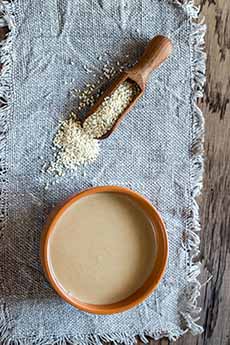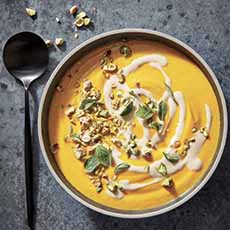TIP OF THE DAY: Uses For Tahini Beyond Hummus
|
If you like nutty flavors, you’ll like tahini (photo #1): a creamy, nutty paste made from ground sesame seeds. It’s familiar to every fan of hummus (photo #3). Most Americans buy tahini to make hummus or baba ghanoush. If you eat halvah, you’ve eaten tahini-based candy. Tahini is also the base of tarator sauce (the recipe is below**), a multipurpose Middle Eastern staple used for meats, vegetables and seafood, plus falafel (photo #4), shwarma and other pita sandwiches. The history of tahini is below. We were inspired by a jar of Once Again Tahini (photo #2) to experiment with uses beyond our favorite Middle Eastern dishes. By the way, along with tahini, Once Again makes artisan nut and seed butters, including almond, cashew, peanut, and sunflower butters. The products have just one ingredient: nuts or seeds. The company is employee owned, and dedicated to Fair Trade, Fair Labor and sustainability. Tahini paste is a Middle Eastern staple. In most Middle Eastern cultures, the paste is called tahina, from the Arabic tahn, meaning “ground.” Most Western countries use the Greek spelling, tahini. Think of tahini as sesame butter. You can substitute it for a no-nuts peanut butter. Some fans eat it from the jar, like PB. To make tahini, sometimes the sesame seeds are first roasted, sometimes they are raw. The flavor is an individual preference; although tahini made from raw sesame seeds is lower in fat than tahini made from roasted seeds [source]. The seeds can be hulled or unhulled. You may prefer the hulled seeds because they have a less bitter taste. However, as with whole grains, the unhulled sesame seeds provide more fiber and other nutrition. When tahini is made from unhulled roasted seeds, it’s darker, more bitter, and called sesame butter [source]. Like homemade peanut butter, which lacks the the emulsifiers that keep big brand PBs from separating, some of the natural oil of the ground seeds rises to the top. Just stir it back in before measuring out what you need. Because of tahini’s high oil content, it should be refrigerated after opening to keep it fresher, longer. You can even freeze it. Seeds—chia, flax, hemp, pumpkin, sesame, sunflower—are good for you (more about seed nutrition). Tahini, in particular: There’s so much more to do with that bottle or can of tahini paste that is a step apart from Middle Eastern cuisines. Use it to make fusion food: the integration of ingredients from one cuisine into another. Tahini can be mixed in to other foods, thinned into a sauce, and used plain or augmented in: Sesame seeds grow in the pods of a flowering plant. The plant, Sesamum indicum, is the best-known member of the genus that includes other annual or perennial herbs with edible seeds. Sesame is native to sub-Saharan Africa and India. The plant is hardy, and can grow in drought conditions [source]. Today sesame is widely grown in India and Asia. The tiny seeds can be in shades of shades of black, brown and red, depending on the cultivar; but the most common color is a pale ivory [source]. Tahini was originally a byproduct of sesame oil production, but became a valued food in its own right. Sesame seed contains between 45% to 55% oil, and is notable for its resistance to rancidity [source]. Sesame seed has been cultivated in Egypt since at least 2 C.E., first as a source of oil. For centuries, only the wealthy could obtain the sesame seeds to make tahini. In some cultures, the seeds were used as currency—much as the hard-to-obtain peppercorns were once used in Europe [source]. Perhaps that’s why “Open Sesame” was chosen as the magical phrase that opened the treasure cave, in the story of Ali Baba and the Forty Thieves (although the tale was written at the beginning of the 18th century, so it may be a stretch). Tahini began to appear in the U.S. in the 1940’s, in health food stores. In 1965, the U.S. passed new immigration reforms, allowing new waves of Arabs, Asians and other nationalities to immigrate [source]. They brought their cuisine with them, of course. Middle Eastern restaurants and grocers ultimately attracted other Americans into the fold. These days you can purchase tahini in most supermarkets. There’s even a tahini dry mix seasoning, made with toasted sesame seeds, black pepper, citric acid, garlic, sea salt and parsley. By the way, in the southern U.S., sesame seeds are known as benne, a name brought from Africa by enslaved people‡. The word “sesame” that we use is of Semitic origin, reaching the English language in the 15th century via the Greek sesamon and Latin sesamum. *In addition to savory tahini/ardeh, in Iran there is halvah ardeh: a sweet, dense paste made with ground sesame or tahini, and occasionally studded with pistachios [source]. †In Indian cuisine, for example, tahini is served with breads, chicken, chickpeas, eggplant, fish, lamb, noodles, etc. It is generally added to make thick and rich gravy based curries [source]. In addition to India, tahini is found in the cuisines of Africa, Israel, Iran, Japan, Turkey, Turkey, even China, Japan, Korea and Vietnam. ‡The word benne (also spelled bene, pronounced benny) means sesame in the language of the Bambara peoples of Mali, and among the Wolof of Senegal and Gambia [source]. **To make tarator sauce and add a fresh tang to almost any dish, just combine 1/2 cup tahini, 1/2 cup lemon juice, 4 cloves minced garlic and 1/4 cup chopped parsley. Pulse in a food processor until combined. ††For an easy dip, add lemon juice, salt and a dash of pepper or hot sauce to the tahini. A recipe for lemon tahini dressing: Combine 1/4 cup tahini, 3 tablespoons lemon juice, 1 clove pressed garlic, 1 tablespoon chopped cilantro, 4 tablespoons water (or enough to reach desired consistency), and salt and pepper to taste. ‡‡An easy tahini dressing recipe: Combine in a blender or food processor 1/2 cup tahini and 1/2 cup olive oil with 2 teaspoons apple cider vinegar, 2 teaspoons of lemon juice, and 2 teaspoons of grated ginger. Pulse and serve. |
|
|
|
|
||













